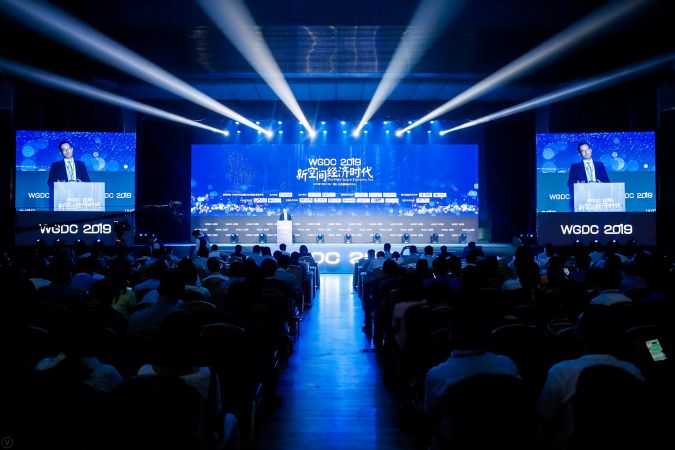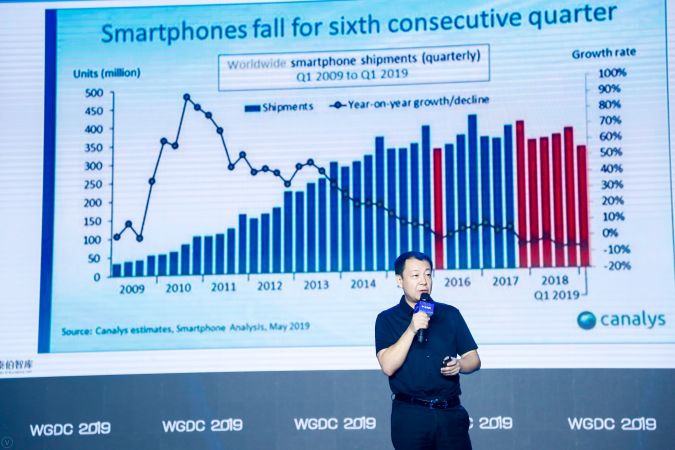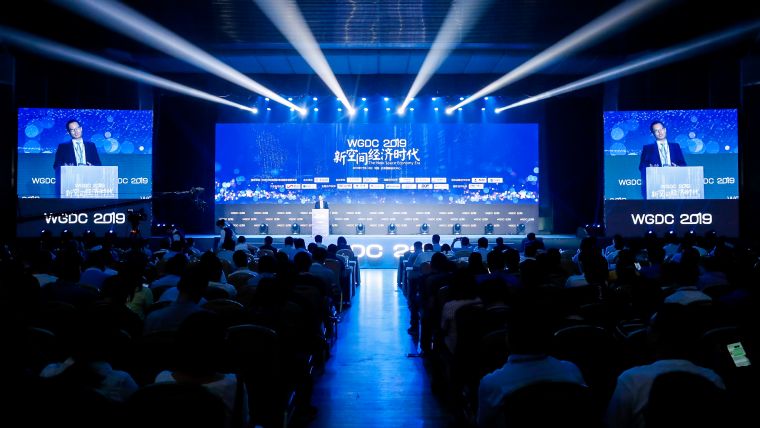New Space Economy Era Presented at WGDC2019
‘New Space Economy Era’ was the theme of this year’s World Geospatial Developers Conference (WGDC2019), organized by Taibo and held from 9-10 July at the International Convention Center in Beijing, China. WGDC2019 brought together top geospatial information industry experts, leaders from application departments, and representatives of institutions, enterprises, investors and the media. The programme included 50-plus reports and over ten panel discussions, covering commercial aerospace, 3D scanning technology, G-TECH, high-precision maps and autonomous driving, land and space planning, smart city and digital government among other topics. The event highlighted the new space economy era against the backdrop of the integration of science and technology as well as industrial integration.
Opening Ceremony
In the opening ceremony, leaders from the fields of politics, academia and business shared their views and insights into how geospatial science and technology is driving the future economy, illustrating the ever-expanding value and potential of geospatial data. Baidu, Tencent, Alibaba, Huawei, Xiaomi, Inspur and other tech giants have entered the arena in recent years. As Liu Song, VP of Alibaba Group, mentioned in his speech, industrial upgrading has experienced the recording, distributing and cognitive revolution one after another from the informatization age to the internet consumption age and then to the industrial internet age. He was in no doubt that the integration of the substantial economy and digital technology will lead the way.
The Trends Report on 2019 China’s Geospatial Industry, a joint effort by Taibo Research and Z-ventures, was launched during the opening ceremony. Chuang Tao, president of Z-ventures, founder of Wayz.ai and consultant of Taibo Research, interpreted the report from the perspectives of users, technology, the market and capital. “AI traffic will grab the relay baton from internet traffic to be the driving force of global technology market value,” he stated. According to his prediction, the scale of core industry of artificial intelligence (AI) in 2019 will exceed RMB57 billion. AI will drive the emergence of new markets for the geospatial information industry and we are on the brink of the real internet era of this industry.

Parallel Sessions
During the two days, seven parallel sessions were held: commercial aerospace, 3D scanning technology, G-TECH, high-precision maps and autonomous driving, land and space planning, smart city and digital government and first industry chain trade fair. Of all the geospatial information companies, few are working as hard as remote sensing companies. Wen Xu, director of China Center for Resource Satellite Data and Application, noted that among communications, navigation and remote sensing, communications and navigation themselves are involved in data transmission or direct applications, which explains the high level of commercialization. However, acquiring images is only the very first step in the process, hence the slower commercialization of remote sensing.
One commercial aerospace report was released during the commercial aerospace summit, which notes the diversity of remote sensing business models globally, although all the business models are intended to solve the “slow, expensive and difficult” problems. Fuhu Ren, executive director of Cooperative Innovation Center of Spatial Big Data, mentioned that cloud computing will contribute to solving the above problems.
The first geospatial information industry chain trade fair can be regarded as a complete success. One representative from a smart city service provider in Guangdong said, “I was surprised that we were hit by a three million intention order in the first round of talks.” Only representatives above VP level are admitted to this session.
Closing Ceremony
During the closing ceremony, Chenghu Zhou, an academic from the Chinese Academy of Sciences, pointed out that the new GIS era requires leapfrogging development. Zhang Yi, director of the Wireless Positioning Capability Center of Huawei, stressed that the connection of everything serves as the basis for 5G industrial development in an intelligent society. According to GSMA, the number of industrial internet connections in the world will reach 13.8 billion by 2025. The number of connections in Greater China alone will be about 4.1 billion, accounting for almost one third of the global market. Considering its characteristics of short delay, high reliability and large bandwidth and nature of ubiquitous perception, connection and intelligence, 5G will become the key element for building the industrial internet system.
Xin Chen, director of the High Level Auto Drive Engineering Department at Here Technologies, summarized that the next-generation maps will be high-precision, multi-dimensional, dynamic, large-scale and quantitative maps. In order to achieve this, the essential factors will be data acquisition, analysis and extraction, training and execution. CIMC Leo Satellite IoT Industrial Park in Shenzhen and Taibo agreed on a strategic partnership and signed a strategic cooperation agreement. The closing ceremony also included the presentation of the Best of WGDC2019 awards.


Value staying current with geomatics?
Stay on the map with our expertly curated newsletters.
We provide educational insights, industry updates, and inspiring stories to help you learn, grow, and reach your full potential in your field. Don't miss out - subscribe today and ensure you're always informed, educated, and inspired.
Choose your newsletter(s)












